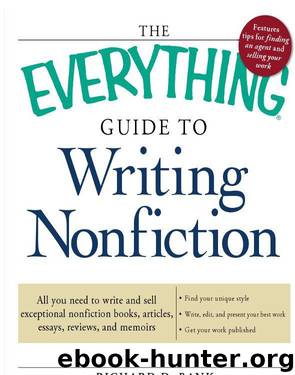The Everything Guide to Writing Nonfiction by Richard D. Bank

Author:Richard D. Bank
Language: eng
Format: epub
Tags: ebook, book
Publisher: Adams Media, Inc.
Published: 2010-07-15T00:00:00+00:00
Techniques in Writing Articles
Most of the techniques you saw in Chapter 1 apply to writing articles— particularly grammar, punctuation, and word count. There are also some techniques that are particularly important when it comes to writing articles.
You must respect the parameters of the word count when you receive an assignment to write an article. Space is a critical factor facing editors when it comes to magazines and other periodicals. Don’t have an extra fifty words and leave it to the editor to decide what to excise or be short a hundred words assuming some extra spacing can pad what is missing.
Tone and Voice
While your writing should reflect your “voice” that was developed in Chapter 1, it is important that the tone of your article be consistent with the publication in which it is to appear. For example, a humorous, carefree style combined with compatible language would be an appropriate tone if you’re writing a piece on how to avoid bad blind dates for a readership of twenty-somethings but not suitable if you’re doing an informative article on Alzheimer’s for AARP Magazine.
And speaking of “voice,” when writing nonfiction—especially articles, it is often important that you write with a voice of authority. Even if you are not an expert in the subject of your article, the reader needs to trust that you know what you are talking about. To do this you need to sound confident and also dispense facts and information. Avoid couching your claims with “possibly” or “perhaps” and similar limitations. On the other hand, just because you are an expert does not mean you have to sound superior and talk down to the reader. The voice can and should be friendly and accessible.
Bullets and Anecdotes
When you hear the word bullets, you probably think of the slugs of lead that blast from a gun. It’s no coincidence that this is the term used to describe lists that appear with dots or asterisks placed before them in some books and many articles. Bullets are meant to quickly dispense important information in a way that stands out. You will find many bullets in this book and you’ll probably need to create some in the articles you write.
Anecdotes are common in nonfiction. They belong exclusively to nonfiction because they are true (you’ll see how to protect yourself from potential legal liability about the people depicted in your anecdotes in Chapters 20 and 21) but more important, they can be fun to write and in an entertaining way convey useful information. While in a book anecdotes may cover several pages, in an article they should be no more than a paragraph or two.
Download
This site does not store any files on its server. We only index and link to content provided by other sites. Please contact the content providers to delete copyright contents if any and email us, we'll remove relevant links or contents immediately.
Kiss My Asterisk by Jenny Baranick(1227)
The Only Grammar Book You'll Ever Need: A One-Stop Source for Every Writing Assignment by Thurman Susan(1207)
Writing CopyFor Dummies by Jonathan Kranz(1198)
BRADBURY, Ray by Zen in the Art of Writing (pdf)(983)
English Verb Tenses Up Close by Mark Lester(954)
Writing Fiction by Gotham Writers' Workshop(919)
The Copywriter's Handbook by Robert W. Bly(803)
It's Never Too Late to Begin Again by Julia Cameron(792)
crafting dynamic dialogue by editors writers digest(752)
Telling Lies for Fun & Profit by Lawrence Block & Sue Grafton(748)
The Psychology Workbook for Writers by Darian Smith(746)
The Grammar Devotional by Mignon Fogarty(720)
How to Not Write Bad by Ben Yagoda(718)
The Book of Ruby(690)
100 Successful College Application Essays by The Harvard Independent(668)
Writing Tools: 50 Essential Strategies for Every Writer by Roy Peter Clark(653)
Steal This Plot: A Writer's Guide to Story Structure and Plagiarism by William Noble & June Noble(627)
How to write Science fiction and Fantasy by Orson Scott Card(615)
Inland by Gerald Murnane(612)
